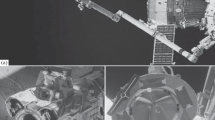Abstract
This paper describes the design and analysis of a research testbed developed to study the control of manipulator-coupled spacecraft with independent attitude control systems. This scenario could present itself in the assembly of Space Station Freedom (SSF). SSF assembly calls for a rendezvous of the Space Shuttle (SS) with SSF. Part of the assembly process requires that both spacecraft be coupled via the Space Shuttle Remote Manipulator System. An additional criterion that poses increased complexity is that the Space Shuttle controls and Space Station controls can not communicate. The technical issue involved is unwanted vibrations of the coupled-configuration that occur retraction and the complications due to non-interacting control systems. To understand these vibrations and possible complications, a research testbed has been built at the Marshall Space Flight Center in Huntsville, AL.
To build the testbed, the manipulator links joints, and vehicles that represent the Space Shuttle and Space Station had to be designed. Pre-design simulation studies using ANSYS [1] (a Finite Element Computer Code) is used to size and design the manipulator links for the experimental facility. The ANSYS results were verified by the development of the Lagrangian Equations of motion. The Harmonic drives used as joints for the two link, three joint manipulator have been dissected into free body diagrams to ensure proper load paths in the ANSYS models. Accurate simulation of manipulator-coupled spacecraft is an important technology for NASA to understand. This paper outlines the methodology behind the preliminary design of a research testbed developed to help NASA gain knowledge in this area.
Similar content being viewed by others
Explore related subjects
Discover the latest articles, news and stories from top researchers in related subjects.References
Swanson Analysis Systems, Inc., Houston, PA:ANSYS Engineering Analysis System User's Manual, Vols. 1 and 2, Rev. 4.4, 1989.
Space Station Freedom Fact Sheet, Obtained from the public relations office at the Marshall Space Flight Center, Huntsville, AL, March 1992.
Thompson, William T.:Theory of Vibration with Applications, Fourth Edition, Prentice-Hall, 1993.
Spong, M. W.: Modeling and control of elastic joint robots,Trans. of the ASME J. of Dynamic Systems, Measurement, and Control 109 (1987).
Kosuge, K., Takeuchi, H. and Fusuta, K.: Motion control of a robot arm using joint torque sensors,IEEE Trans. on Robotics and Automation 6(2) (1990).
Hashimoto, M.: Robot motion control based on joint torque sensing,Proc. of the 1989 IEEE Int. Conf. Robotics and Automation, Scottsdale, AZ, May 1989.
Uicker, J. J.: On the Dynamic Analysis of Spatial Linkages Using 4 × 4 Matrices, PhD Dissertation, Northwestern University, 1965.
Bejczy, A. K.:Robot Arm Dynamics and Control, Technical Memorandum 33–669, Jet Propulsion Laboratory, February 1974.
Paul, R. P.: Modeling Trajectory Calculation and Servoing of a Computer Control Arm, PhD Dissertation, Stanford University, August 1972.
Hollerbach, J. M.: A Recursive Lagrangian formulation of manipulator Dynamics and a comparative study of Dynamics formulation complexity,IEEE Trans. on Systems, Man, and Cybernetics SMC-10(11) (1980).
Luh, J. Y. S., Walker, M. W., and Paul, R. P.: On-line computational schemes for mechanical manipulators,Trans. of ASME, J. of Dynamic Systems, Measurement and Control 102, June 1980.
Horowitz, R. and Tomizuka, M.: Am adaptive control scheme for mechanical manipulators-compensation of nonlinearity and decoupling control,ASME Paper 80-Wa/DSC-6, 1980.
Hashimoto, M., Kiyosawa, Y., Horiuchi, T., and Hirabayshi, H.: The effects of joint flexibility on robot motion control based on joint torque positive feedback,Proc. of the IEEE International Conference on Robotics and Automation, Sacramento, CA, April 1991.
Tissue, D. K.:An Adaptive Control Scheme for Flexible Joint Mechanical Manipulators, Masters Thesis, University of Hawaii at Manoa, Dec. 1989.
Hashimoto, M., Kiyosawa, Y., Hirabayashi, H., and Paul, R. P.: A joint torque sensing technique for robots with harmonic drives,IEEE International Conference on Robotics and Automation, Sacramento, CA, April 1991.
Dynacs, Inc., Clearwater, FL: User's Manual for TREETOPS, Rev. 8, 1990.
Redzone Robotics, Inc., Pittsburgh, PA: Harmonic Drive Gearing, Pancake Type HDUR and HIUR Component Sets.
Author information
Authors and Affiliations
Rights and permissions
About this article
Cite this article
Crytser, T., Nandi, G.C., Hinman-Sweeney, E.M. et al. Finite element design of manipulator-coupled spacecraft for a research testbed. J Intell Robot Syst 13, 75–91 (1995). https://doi.org/10.1007/BF01664756
Received:
Accepted:
Issue Date:
DOI: https://doi.org/10.1007/BF01664756




